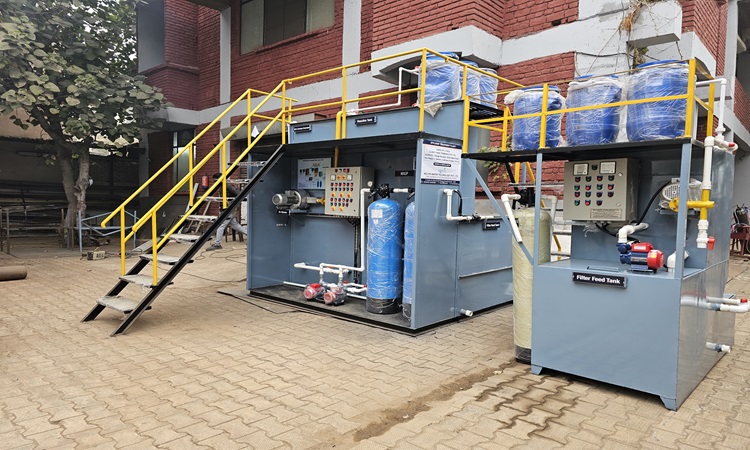How STP Plant Reduces Water Pollution and Saves the Environment?

In today’s rapidly urbanizing world, water pollution has become a critical environmental challenge. Industrial growth, population expansion, and improper waste disposal have severely impacted natural water bodies. Among the leading solutions to this growing problem is the STP Plant — an essential facility designed to treat and recycle wastewater efficiently. By treating sewage before it reaches rivers or lakes, STP plants play a key role in reducing water pollution and promoting environmental sustainability.
What is an STP Plant?
An STP Plant, or Sewage Treatment Plant, is a system designed to treat domestic, industrial, and commercial wastewater. The sewage contains organic matter, suspended solids, harmful microorganisms, and toxic chemicals that can severely damage the environment if left untreated.
A well-designed STP system processes this sewage through physical, chemical, and biological stages to remove contaminants. The treated water can then be reused for non-potable purposes like gardening, cooling, and flushing, or safely discharged into the environment.
Leading STP Plant Manufacturers in India, such as Kelvin Water Technologies Pvt. Ltd., design and supply advanced sewage treatment systems that meet CPCB (Central Pollution Control Board) standards and help industries and residential societies manage wastewater sustainably.
Main Stages of Sewage Treatment
The STP process is carried out in several key stages, each responsible for removing different types of pollutants from wastewater.
1. Preliminary Treatment
This initial stage removes large debris such as rags, plastics, and sand using bar screens and grit chambers. It prevents damage to pumps and downstream equipment, ensuring smooth operation of the plant.
2. Primary Treatment
In this stage, sewage is allowed to settle in sedimentation tanks. Heavy solids settle at the bottom as sludge, while lighter materials like oils float on the surface and are skimmed off. Around 60% of suspended solids are removed in this process.
3. Secondary (Biological) Treatment
The biological stage uses microorganisms to break down organic pollutants. Common systems include:
- Activated Sludge Process (ASP)
4. Tertiary (Advanced) Treatment
The tertiary stage focuses on fine purification through filtration, disinfection, and nutrient removal. Advanced techniques like UV disinfection, chlorination, and reverse osmosis are used to produce water suitable for reuse.
How STP Plants Reduce Water Pollution?
1. Removal of Pathogens and Harmful Bacteria
Untreated sewage carries millions of harmful microorganisms that cause diseases like cholera, typhoid, and dysentery. Sewage Treatment Plants eliminate these pathogens through biological and chemical processes, ensuring clean water discharge.
2. Reduction of Toxic Chemicals
Household detergents and industrial effluents often contain chemicals like phosphates, nitrates, and heavy metals. The STP process effectively neutralizes or removes these contaminants, protecting rivers, lakes, and groundwater from chemical pollution.
3. Prevention of Eutrophication
Excess nutrients in untreated wastewater lead to excessive algae growth, reducing oxygen levels in water and killing aquatic life. STP plants remove these nutrients, preventing eutrophication and preserving aquatic ecosystems.
4. Safe Disposal of Sludge
Solid waste or sludge collected during treatment is processed separately. After treatment, it can be used as organic fertilizer or for biogas generation, ensuring zero waste discharge and promoting sustainable waste management.
5. Protecting Groundwater Resources
In areas without proper sewage systems, untreated wastewater often seeps into the ground, polluting underground water reserves. STP Plants prevent this by treating sewage effectively, keeping groundwater clean and safe.
Environmental Benefits of Sewage Treatment Plants
1. Water Recycling and Reuse
One of the greatest benefits of an STP plant is water reuse. The treated water can be used for landscaping, irrigation, industrial cooling, and toilet flushing. This reduces the dependency on freshwater sources, promoting sustainable water conservation.
2. Reduced Carbon Footprint
Modern Sewage Treatment Plants are designed with energy-efficient components. Some even generate biogas from sludge digestion, which can power plant operations, reducing energy costs and the overall carbon footprint.
3. Protection of Ecosystems
By ensuring only treated water is released into rivers or lakes, STP systems maintain ecological balance and protect aquatic biodiversity. Clean water supports healthy fish populations and preserves natural habitats.
4. Promotion of Circular Economy
Treated water reuse, sludge utilization, and biogas recovery are examples of circular economy practices promoted by STP plants, ensuring resources are reused instead of wasted.
5. Sustainable Urban Development
With rapid urbanization, effective wastewater management is crucial. Sewage Treatment Plants support green infrastructure, keeping cities clean and environmentally responsible.
Role of STP Plants in Public Health Protection
Clean water is directly linked to better public health. By treating wastewater and preventing contamination, STP plants minimize the risk of waterborne diseases. They also ensure that water used in agriculture is free from harmful toxins, supporting food safety and community health.
Municipalities and residential complexes that install STP systems contribute directly to a cleaner, healthier living environment for their residents.
Government Regulations and Standards
The Central Pollution Control Board (CPCB) and local pollution control boards in India mandate wastewater treatment before discharge. Every residential society, commercial complex, and industry generating sewage must install an STP Plant as per environmental norms.
Leading STP Plant Manufacturers in India, like Kelvin Water Technologies Pvt. Ltd., provide complete solutions — from design and manufacturing to installation and maintenance — ensuring full regulatory compliance and long-term efficiency.
Why Choose a Professional STP Plant Manufacturer in India?
Choosing the right manufacturer is critical for efficiency and compliance. A professional STP Plant Manufacturer in India offers:
- Custom design based on sewage load and application
- Energy-efficient and low-maintenance systems
- Compliance with CPCB and NGT norms
- Reliable after-sales service and AMC support
Conclusion
An STP Plant is more than just a wastewater treatment unit — it is a vital tool for reducing water pollution and saving the environment. By removing contaminants, recycling water, and preventing disease spread, these plants protect both human health and natural ecosystems.
In an era of increasing water scarcity, Sewage Treatment Plants represent a sustainable and responsible approach to water management. Partnering with a trusted STP Plant Manufacturer in India, like Kelvin Water Technologies ensures efficient performance, regulatory compliance, and long-term environmental protection.